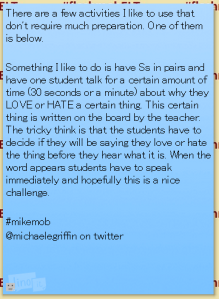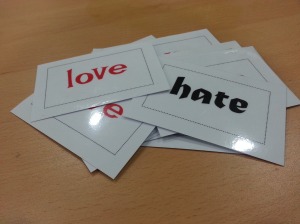Mike posted this idea on the #flashmobELT lino board – a place to crowdsource ELT activity ideas. #flashmobELT is a great idea about sharing activities and also sharing follow-through experiences. Ann Loseva and Mike have written posts explaining it. I used this activity, and I also posted an activity I use on the lino board in return.
I like Mike’s idea because it’s so elegantly simple and it has in-built communicative pressure (‘sound convincing’).
Well, what’s a public school teacher to do with such an elegant idea? Turn it into something that involves sweating away over the laminating machine!
Most of my students aren’t advanced enough to do the original version. I initially chose it to use with my higher level middle school 3rd grade ‘free talking’ class. We’ve done ‘talk for 30/60/90 seconds’ activities before and this seemed like an engaging twist on that. So I mentally put this activity aside for them.
Meanwhile, I was grasping for things to do with my middle school 1st grade After School class. This class is a mix of one or two higher level students and some quite low level students who joined recently. The low level students are low by the standards of 1st grade overall and struggle to get out much language at all. Maybe later I could post a deeper reflection about my problems and challenges coming up with appropriate activities for the class. But the short version is: I recently embraced using vocabulary and sentence games with them, and I was looking for some more games that might be fun.
So I decided to turn Mike’s lovely elegant fluency activity into a simple sentence game. I made and laminated the cards above, and made a really quick Google presentation with pictures of things like spiders, puppies, snow, our city…
In class:
-We used examples to work out an ‘I love/hate ~ because…’ pattern together, which I put on the board.
-I modeled choosing either a love or hate card and holding it up, before revealing the prompt on screen and making a sentence. (Students got it without trouble, which was great because even when I think there couldn’t possibly be any confusion about an activity i have modeled they will still ask the co-teacher for translation.)
-I gave students a love and a hate card each and had them choose one and hold it up before each reveal.
The students were engaged enough that we continued for 25 or 30 minutes. My presentation ran out of topics, but I just started searching for things in Google Images. A picture of cute cartoon poos was a popular choice.
Because it worked well, I re-used the activity as a warmer for my final (ever) class with regular 3rd grade middle school students, but it evolved a slight variation:
-I chose two students (sometimes from ‘teams’) to come up to the front of the class, where I offered them one love and one hate card between them.
-The two students did rock-paper-scissors to decide who could choose first. The loser was stuck with whatever was left.
-I revealed the prompt and asked the students why they loved or hated it – normally beginning with the student who had an easier answer to come up with. Then we decided whose answer sounded more truthful.
-The students chose who would replace them.
Here are some things I liked about this activity:
-Maybe the cards detract from the elegance of the idea, but they did make the experience more tactile, which I think was helpful for younger and lower level students. It was also a way of committing to ‘love’ or ‘hate’ with body language – students had to hold up the card in front of them for everybody to see.
-There was some good humor in the reveals of the topics, and here again the body language added to the experience. It was funny in a slightly-teasing-but-not-really-mean way to have students standing in front of the class holding up their ‘love’ card while a picture of cartoon poos appeared behind them.
-By having a pattern to follow which students were willing to correct each other on, the activity combined attention to accuracy with communicative pressure (‘give a good answer quickly and make it sound convincing’). This is a genre of sentence game I have recently come to quite like.
-This is a ‘game-that’s-not-quite-a-game’, because there’s not necessarily a goal or winners or anything. Games like this can be really useful because they’re flexible and leave you room to make it up as you go along in class.
Here are some possible problems:
-Some students could obviously offer more than just a basic sentence, but done this way the activity didn’t encourage it.
-Students sometimes seemed mildly annoyed they couldn’t give their real answer (here Ann Loseva suggests it might be worth giving students the chance to share real answers).
-There’s a risk of real teasing, as opposed to playful teasing. (I like using activities that involve a degree of playful teasing, but it’s a fine line.)
Overall it was an engaging activity that got some involvement from almost all students.
As for my higher level 3rd graders who I wanted to hear express immediate love or hate eloquently at length? With their finals over and acceptance or rejection from foreign language high schools already decided, those good-for-nothing cartoon poo lovers never turned up for After School again. ㅜㅜ


